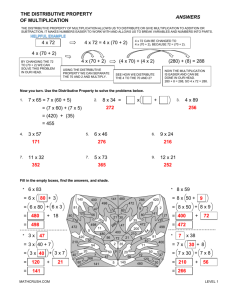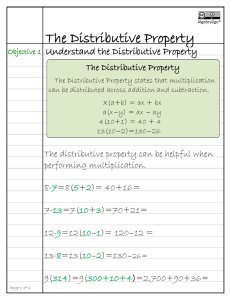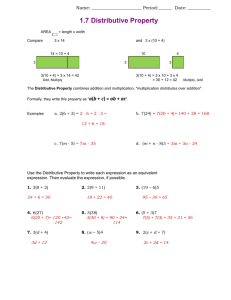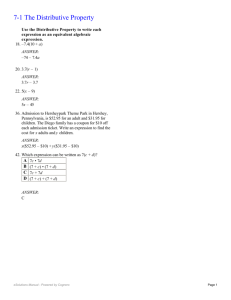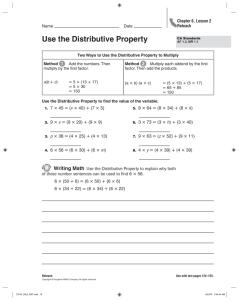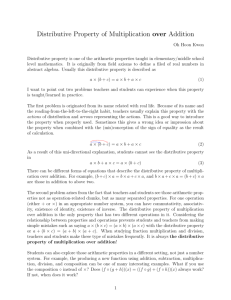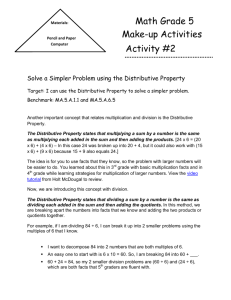Distributive Property
advertisement
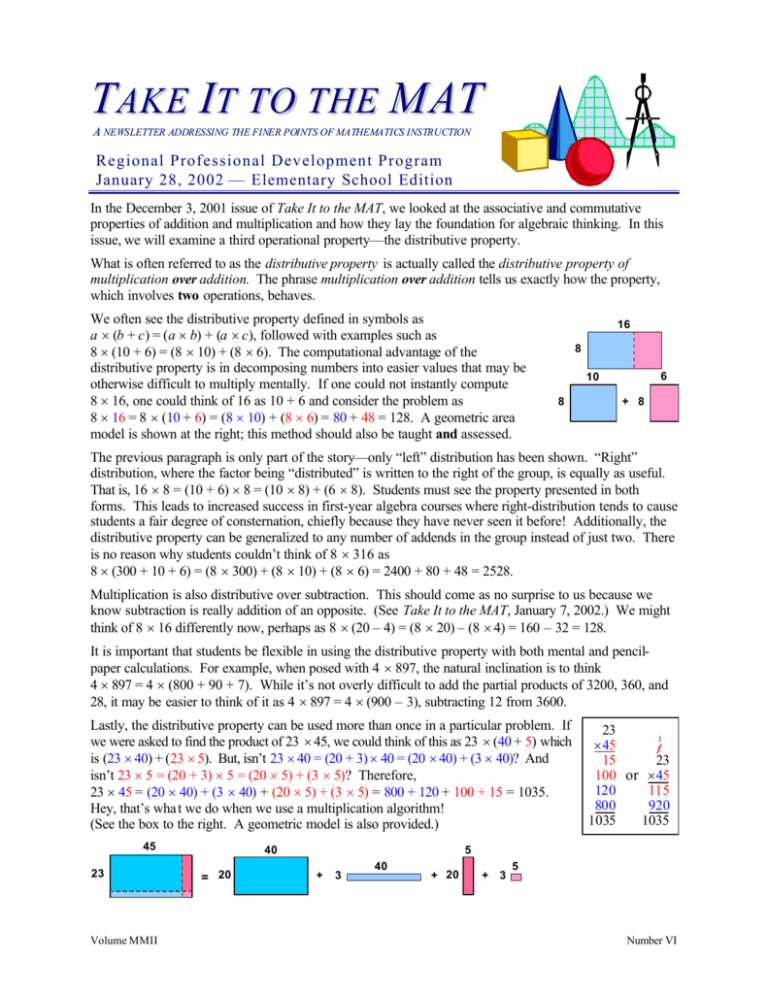
T A K E I T T O T HE M AT A NEWS LETTER ADDRES SING THE FINER POINTS OF MATHEMATICS INS TRUCTION Regional Professional Development Program January 28, 2002 — Elementary School Edition In the December 3, 2001 issue of Take It to the MAT, we looked at the associative and commutative properties of addition and multiplication and how they lay the foundation for algebraic thinking. In this issue, we will examine a third operational property—the distributive property. What is often referred to as the distributive property is actually called the distributive property of multiplication over addition. The phrase multiplication over addition tells us exactly how the property, which involves two operations, behaves. We often see the distributive property defined in symbols as a × (b + c) = (a × b) + (a × c), followed with examples such as 8 × (10 + 6) = (8 × 10) + (8 × 6). The computational advantage of the distributive property is in decomposing numbers into easier values that may be otherwise difficult to multiply mentally. If one could not instantly compute 8 × 16, one could think of 16 as 10 + 6 and consider the problem as 8 × 16 = 8 × (10 + 6) = (8 × 10) + (8 × 6) = 80 + 48 = 128. A geometric area model is shown at the right; this method should also be taught and assessed. 16 8 6 10 8 + 8 The previous paragraph is only part of the story—only “left” distribution has been shown. “Right” distribution, where the factor being “distributed” is written to the right of the group, is equally as useful. That is, 16 × 8 = (10 + 6) × 8 = (10 × 8) + (6 × 8). Students must see the property presented in both forms. This leads to increased success in first-year algebra courses where right-distribution tends to cause students a fair degree of consternation, chiefly because they have never seen it before! Additionally, the distributive property can be generalized to any number of addends in the group instead of just two. There is no reason why students couldn’t think of 8 × 316 as 8 × (300 + 10 + 6) = (8 × 300) + (8 × 10) + (8 × 6) = 2400 + 80 + 48 = 2528. Multiplication is also distributive over subtraction. This should come as no surprise to us because we know subtraction is really addition of an opposite. (See Take It to the MAT, January 7, 2002.) We might think of 8 × 16 differently now, perhaps as 8 × (20 – 4) = (8 × 20) – (8 × 4) = 160 – 32 = 128. It is important that students be flexible in using the distributive property with both mental and pencilpaper calculations. For example, when posed with 4 × 897, the natural inclination is to think 4 × 897 = 4 × (800 + 90 + 7). While it’s not overly difficult to add the partial products of 3200, 360, and 28, it may be easier to think of it as 4 × 897 = 4 × (900 – 3), subtracting 12 from 3600. Lastly, the distributive property can be used more than once in a particular problem. If we were asked to find the product of 23 × 45, we could think of this as 23 × (40 + 5) which is (23 × 40) + (23 × 5). But, isn’t 23 × 40 = (20 + 3) × 40 = (20 × 40) + (3 × 40)? And isn’t 23 × 5 = (20 + 3) × 5 = (20 × 5) + (3 × 5)? Therefore, 23 × 45 = (20 × 40) + (3 × 40) + (20 × 5) + (3 × 5) = 800 + 120 + 100 + 15 = 1035. Hey, that’s wha t we do when we use a multiplication algorithm! (See the box to the right. A geometric model is also provided.) 45 23 Volume MMII 40 = 20 23 1 × 45 1 15 23 100 or × 45 12 0 11 5 80 0 920 1035 1035 5 + 3 40 + 20 + 3 5 Number VI
